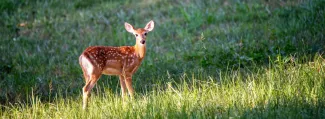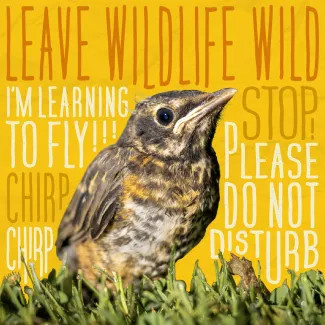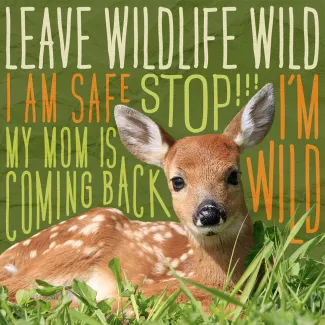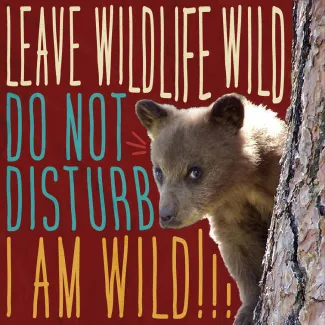
Spring and early summer is when people commonly come across newborn and young wildlife. The best thing to do if you come across young wildlife is to keep them wild and, in most cases, leave them alone and don’t interfere.
What to do if you find young wildlife
People often imagine that any young animal they see must be lost or abandoned, but usually, that is not the case. Chances are an adult animal is nearby and is simply waiting on you to move away so they can take care of their young.

Baby Birds
If you find a featherless baby bird with its eyes still shut, it is a nestling and isn’t ready to leave the nest yet. The best thing to do is simply place the nestling back in the nest. If you cannot locate the nest, leave the nestling where you found it or move it to a shaded area. Your scent won’t deter the parents and they will come back to take care of the bird.
More developed birds are fledglings. They can easily be identified by their more developed feathers. Fledglings don’t need help – their parents are nearby and still caring for them. Be sure to give them plenty of space.

Fawns
In Oklahoma, most fawns are born in May and June. And that’s when people begin seeing the young animals.
If you find a fawn without a parent nearby, that is normal. In order to produce milk, the doe needs to eat. She will often leave the fawn in a safe place, such as near a house or where people can easily see them because those are places where predators might be less likely to visit.
The doe will also stay away from its fawn so the doe’s scent will not attract predators. She will be gone for hours sometimes.

Bear Cubs
Black bears and their cubs emerge from their winter dens in early spring. It is not uncommon for bear cubs to become separated from their mothers for short periods of time. If you see a bear cub alone you should leave it alone and leave the area immediately.
Black bears will often "tree" their cubs when they perceive a threat. While the cubs are in the trees, the mother bear will leave and circle back periodically to check on the cubs. They will leave when she feels the area is safe.
Injured Wildlife
If an animal truly needs help, you’ll need to find a licensed wildlife rehabilitator. A list of rehabilitators by county is available at www.wildlifedepartment.com/law/rehabilitator-list.
When people interfere with young wildlife, those animals will lose their instinctual fear of people and begin to bond with and depend on people to survive. If returned to nature later, these animals will not be able to feed or be aware of what dangers to avoid. And the young animal could even die from the stress of being handled by people.
Other Wildlife
In addition to birds, springtime storms may blow young squirrels out of their nests. Even though they may appear to be alone, distressed or in need of help, the parents are often nearby and will care for them.